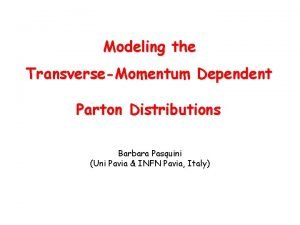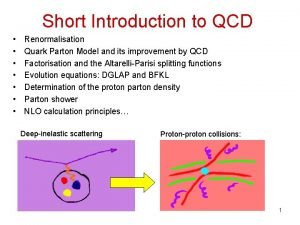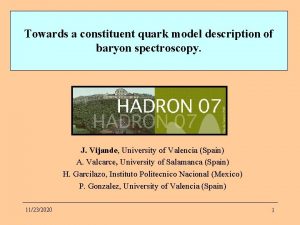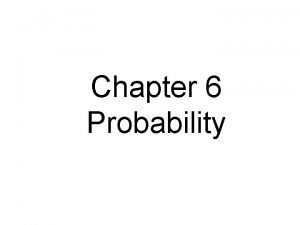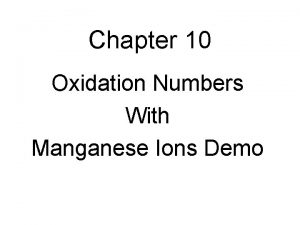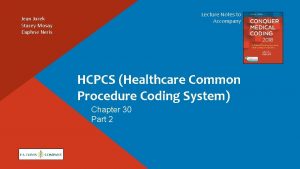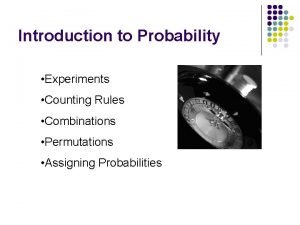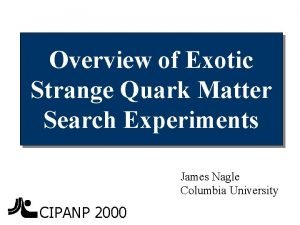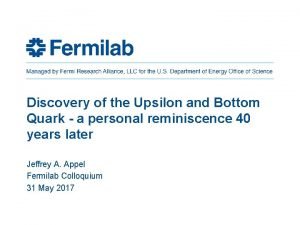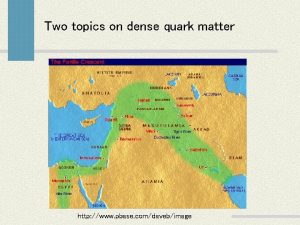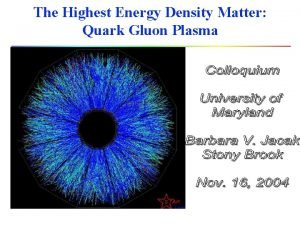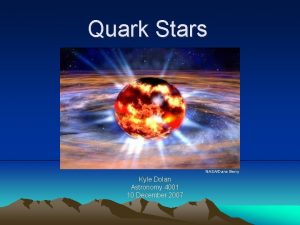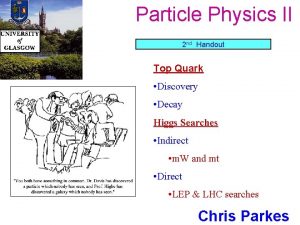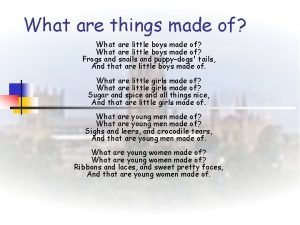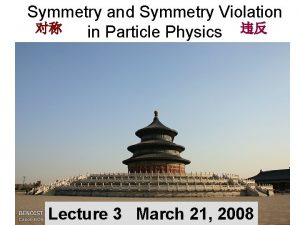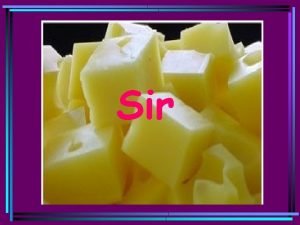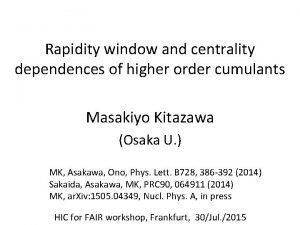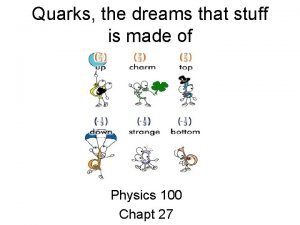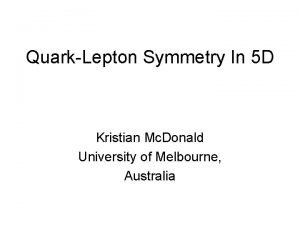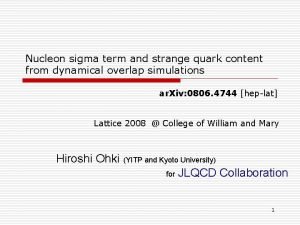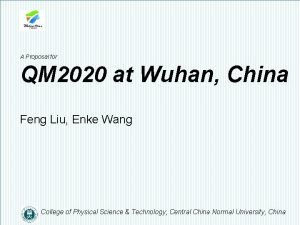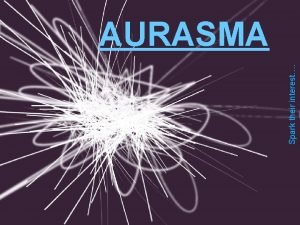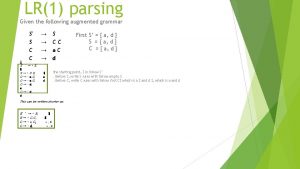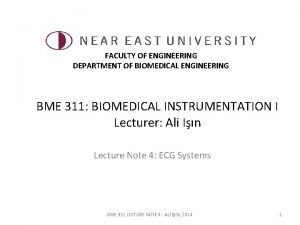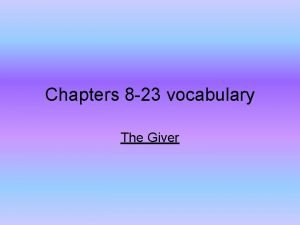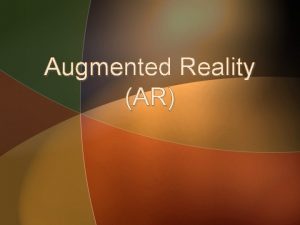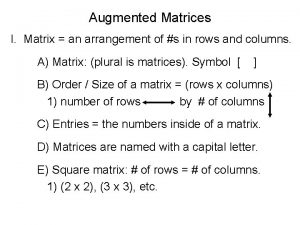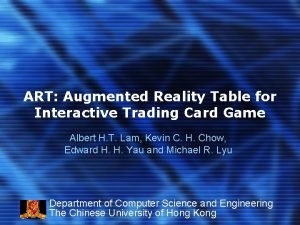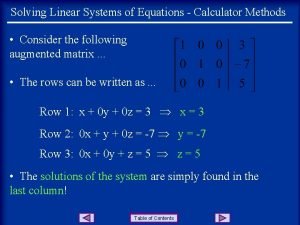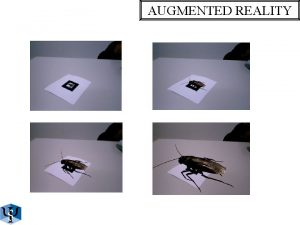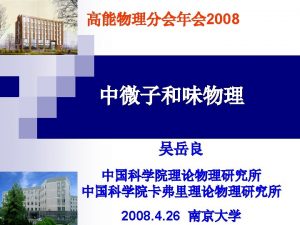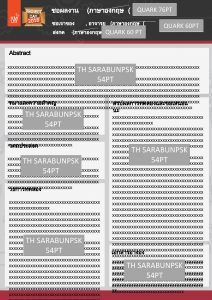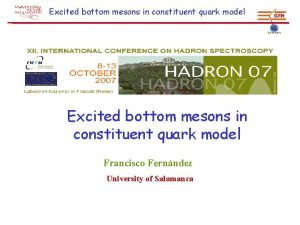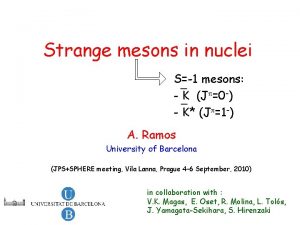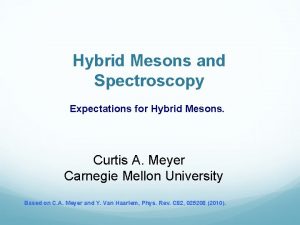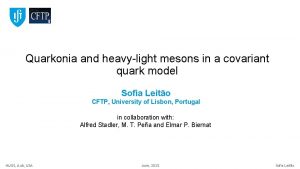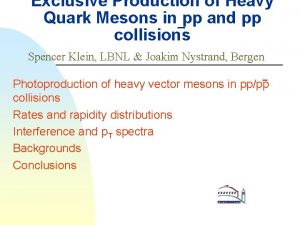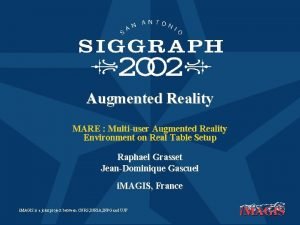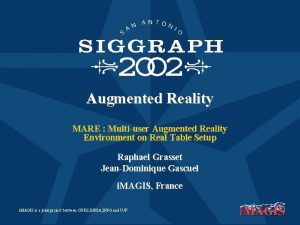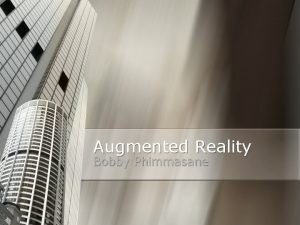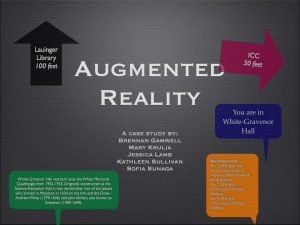Assigning A Mesons Internal State Quark Model Augmented











































- Slides: 43

Assigning A Meson’s Internal State: Quark Model Augmented by Strings. Bilal Masud Centre for High Energy Physics University of the Punjab Collaborators: Eric Swanson Fasial Akram Nosheen Akbar M. Atif Sultan Ishrat Asghar International Scientific School-2017, 13 -17 March 2017 1

Outline • 2

Quark Model • Quark model is an approximation to in which all the properties of the hadrons are understood in terms of only quark properties. • This can be compared with Adiabatic (or Born. Oppenheimer) approximation in molecular physics, where the all properties of a system of nuclei and electrons are understood in terms of properties of the nuclei only, with electron cloud giving an effective potential between nuclei, etc. • In hadronic physics, analogue of nuclei are quarks and that of the electronic cloud is the gluonic field between them. Quark model means trivial gluonic field. 3

Quark Flavours and Colour charge. • Nucleons and other hadrons are composed partons (quarks and gluons). • The electric charge and mass define flavour u, d, s, c, b, t • Quarks have on them a new kind of charge, called colour charge, in addition to fractional electrical charge. • Three colour charges making a neutral “white” (singlet of SU(3) colour) nucleon or meson. • The strength of colour charge is 6 to 10 times more than that of electric charge; varies with momentum 4 transfer (“energy”).

Static Quark Model ( ) Assignments of the Light Spin-Zero Nonet. with The flavour singlet and a state in the centre of the octet are thought to linearly combine to produce eta and eta prime mesons. 5

Typical experimental knowledge about a particle, a meson in this case: Mass, J, P, C and decay widths. Assignment of an internal state through Static quark model means deciding about 1) flavour wave function (content) 2) quark spin wave function (spin 0 or 1, etc. ) • P = -1 • C= (-1)S J= S 6

If J and C are different, along with mass etc. , with the same electric charge: the spin 1 nonet replaces the spin zero nonet. 7

Electric Field and Colour (Chromo) Fields. • The electric field spreads. • The colour field glues and hence forms flux tubes. • Each term in the Fourier Series for the electric field is a photon. • Similarly, the colour field is composed of gluons. • Both photons and gluons have zero rest mass, but gluons carry colour charge and self-interact (glue). • Confinement: Free quarks can not be detected. 8

This is G. S. Bali, K. Schilling, C. Schlichter Phys. Rev. D 51 (1995) 51655198 action density distribution between two static colour sources (e. g. infinitely heavy quarks) from this 1994 simulation of SU(2) gauge theory on a 32^4 lattice. Nowadays one should be able to produce similar results in a finite amount of time on a laptop. Those days we used a so called Connection Machine CM-2. The lattice spacing corresponds to 0. 08 fm and the sources are separated by 18 such lattice units. 9

QCD Strings : This is what happens when the sources (a quark and an antiquark) are pulled apart. In real QCD with sea quarks the ``string'' would break around r = 1. 1 fm. Obviously the field does not look like an electric dipole field but more ``stringy''. Gluonic ground state energy (next slide) fitted by optimum values of the quark model parameters , b, σ and ; the Cornell Model. 10

The parameters can be fitted to above spectroscopy or computer simulations. 11

Born-Oppenheimer Approach (An Adiabatic Approximation): • Mesons with Same Flavour but differing in masses are like different states of a hydrogen atom with fitted potential. • Different Mesons are modeled as different energy states of a hydrogen atom-like system. The potential between quarks is given by a fit to the total energy of the gluonic field for the corresponding quarks configuration. • Thus the principal, orbital and spin quantum numbers in the above table. 12

Dynamical Quark Model J, P and C • In quark model, mesons have the JPC states which satisfies following P and C selection rules. • P = (-1)L+1 • C= (-1)L+S • J= |L-S|+……. . +|L+S| L=0, 1, 2……. . S=0, 1 • Allowed JPC states are 0 -+, 1 --, 1+-, 0++, 1++, 2++. …… 13

14

Assignments of experimentally available Charmonium Mesons based on masses 15

Simplest models of Strong decays • In strong decays flavour is conserved. Thus for a produced quark, there must be a corresponding antiquark. • In general we can have something like the production of • In the simplest models, we can assume that the produced gluonic field has trivial quantum numbers. 16

17

• Possible features of a theory (QCD) based explanation: JKJ model, replacing the helix gluon propagator by by 18

The Hamiltonian of the JKJ model 19

A simpler alternative: Vacuum Pair (Special case of JKJ or constant G in ) Means quark antiquark pair creation with vacuum quantum numbers J=0, P=C=+1. 1965 Micu 20

Implications of the production with vacuum quantum numbers Parity means L is odd C means spin 1 Angular momentum J=0 Thus L is to combine with S=1 to give J=0. This restricts L to be 1. • Hence the name model, P referring to L=1. • • 21

Spinors in the Decay Hamiltonian b†(k) --- creation operator for quark d†(k) --- creation operator for anti-quark 22

The momentum dependence of the spinors gives 23

24

To be compared with experiments: strong decay width 25

The case of using SHO Wave Functions The evaluation of the decay amplitudes require mesonic wave functions which can be: § Simple Harmonic oscillator (SHO) wave functions. § More realistic wave-functions obtained as eigen-states of a Hamiltonian including Coulombic plus linear terms. SHO wave functions have advantage that decay amplitudes can be determined analytically. 26

Some results with SHO wave functions 27

Actual Angular Momentum Structure of the Production Operator • In all the initial orbital angular momenta are zero. The operator has L=1. The result is proportional to or x. (Linear in produced momentum. ) This is also indicated by the first subscript of the two. • In and initial L=1 (indicated by the letter P) combines with L=1 of the production operator to result in the quadratic dependence on the linear momentum. This is a indicated by the first subscripts 0 and 2. 28

(From our work) Strong decay widths of B and Bs mesons The mesons masses used to determine phase space and final state momenta are listed below in Ge. V π=0. 138, K=0. 495, B(11 S 0)=5. 27926, B(13 S 1)=5. 3252, B(13 P 0)=5. 68473, B(13 P 2)=5. 743, Bs(13 P 0)=5. 7855, Bs(13 P 2)=5. 8399. State Mode Γthy (Me. V) B(13 P 0) π B 141. 5 B(13 P 2) π B* total 9. 77 9. 79 19. 56 20± 5 Γexpt (Me. V) State Mode Γthy (Me. V) Bs(13 P 0) K B 135. 66 Bs(13 P 2) K B* 1. 55 0. 13 total 1. 69 1. 47± 0. 33 29

Assignments of experimentally available Bottom Mesons based on masses and decay widths. Experimental State Experimental mass (Me. V) B 1(5721) 5726. 0± 1. 3 5725. 9± 2. 5 B 2*(5747) BJ(5970) 5739. 5± 0. 7 5737. 2± 0. 7 5971± 5 5964± 5 Γ(Me. V) Our Assignment 31± 6 B(1 P 1) Our calculated mass (Me. V) 5755. 12 27. 5± 3. 4 20± 5 B(1 3 P 2) 5768. 95 20. 3 24. 2± 1. 7 62± 20 B(2 3 S 1) 5905. 36 6. 5 Measured 81± 12 Our predicted Γ(Me. V) 16. 4 30

Decay Channels containing Photons: radiative transitions. Photon emission means Electromagnetic interaction. 31

Electric dipole moment • Electric dipole moment is defined as the D=q r with direction from -ve to +ve charge. 32

Decay width of E 1 Transitions • Total decay width of transition from i to f is where is the energy of emitted photon and 33

From our work: E 1 decay widths of Bottom Mesons. E 1 radiative transitions State Mode Photon energy(Me. V) Γthy (ke. V) B(13 P 0) B(13 P 2) B*γ 365. 89 402. 6 175 232 B(13 D 1) B(13 P 0)γ B(13 P 2)γ 310. 31 272. 91 199 7 B(23 S 1) B(13 P 2)γ B(13 P 0)γ 160. 13 198. 27 45 17 34

Assignments of experimentally available Bottomonium Mesons based on masses and Leptonic Decay Widths Exp. State JPC Exp. Mass (Me. V) Our Leptoni c Decay width 0. 23 Ke. V Our Assignme nts 10891± 4 Me. V Exp. Leptonic Decay width 0. 31± 0. 07 ke. V (10860) 1 -- (11020) 1 -- 10987. 5+113. 4 Me. V 0. 130± 0. 0 30 ke. V 0. 20 Ke. V 0. 128* Ke. V (63 S 1) Yb(10890) 1 -- 10888. 4± 3 - * Without relativistic correction (53 S 1) hb(11 P 1) 35

Above mathematical modeling can be seen as special case of QCD Strings 36

Meson decay as a string-breaking Produced quark momentum integration Produced quark position integration 37 Geiger, Swanson, Phys. Rev. D 50 (1994) 6855

(Photon-emitting) E 1 transition (D=q r) as a special case of string vibrations The state of the flux tube (vibrating string) can be written In terms a complete set of transverse eigenstates 38

String Vibrations can model further Numerical Simulations of QCD Gluonic ground state energy (black curve) fitted by optimum values of the quark potential model parameters , b, σ and. Quark potential model extension to hybrids (mesons with excited gluonic field). 39

Hybrid Mesons • Hybrid meson is an quark and antiquark pair with an excited gluonic field. • In the flux tube model, hybrid meson are modeled as a quark antiquark pair with a vibrating string between them that has angular momentum Λ. • Thus 40

Quark Antiquark Potential The potential model 41

String Action and Area https: //en. wikipedia. org/wiki/Nambu%E 2%80%93 Goto_action#cite_note-1 Note: Any arbitrary area is a (continuous) sum i. e. an integral of this infinitesimal parallelogram area. The proportionality of action and area is basic to any string theory not only QCD string theory. Action L=KE-Potential energy. For some special (constant etc. ) case, string action can be proportional to energy*time, meaning energy is proportional to area/time=length in space-time. This can be compared with the linear term in the quark-antiquark potential 42

Conclusions • Quark model started with assigning flavour wave functions of mesons. • Later variety gets many assignments through the quark potential model masses and models of strong, E 1, M 1, leptonic decays and hadronic transitions (last three not actually mentioned above). • Above models can be brought closer of QCD by using features of QCD strings. 43
 Quark model
Quark model Quark parton model
Quark parton model Constituent quark model
Constituent quark model The complement of event a
The complement of event a Assigning oxidation numbers worksheet
Assigning oxidation numbers worksheet Assigning homework and providing practice
Assigning homework and providing practice When assigning hcpcs level ii codes, _____.
When assigning hcpcs level ii codes, _____. Counting rule for multiple-step experiment
Counting rule for multiple-step experiment What is process selection and facility layout
What is process selection and facility layout Quark physics wordle
Quark physics wordle Quarks
Quarks Quark names
Quark names Quark gluon plasma
Quark gluon plasma Quark gluon
Quark gluon Quark astronomy
Quark astronomy Quark gluon
Quark gluon Top quark decay
Top quark decay Quark names
Quark names A charm quark has a charge of approximately
A charm quark has a charge of approximately Zamjena za kačkavalj sir
Zamjena za kačkavalj sir Quark gluon plasma
Quark gluon plasma Quark types
Quark types Quark lepton symmetry
Quark lepton symmetry Sigma quark composition
Sigma quark composition Quark matter 2022
Quark matter 2022 What are the 7 principles of internal control
What are the 7 principles of internal control Audit report of a company
Audit report of a company Augmented reality big data
Augmented reality big data Aurasma augmented reality
Aurasma augmented reality Augmented product example
Augmented product example Mkt 600
Mkt 600 Augmented grammar
Augmented grammar Augmented leads of ecg
Augmented leads of ecg Augmented in the giver
Augmented in the giver Augmented feedback meaning
Augmented feedback meaning Arrmss
Arrmss Augmented reality architecture diagram
Augmented reality architecture diagram Ciri ciri augmented reality
Ciri ciri augmented reality Augmentedmatrix
Augmentedmatrix Augmented grammar in artificial intelligence
Augmented grammar in artificial intelligence Augmented reality table
Augmented reality table Microsoft augmented reality for students
Microsoft augmented reality for students Augmented vector left
Augmented vector left Write augmented matrix for systems of equations calculator
Write augmented matrix for systems of equations calculator
